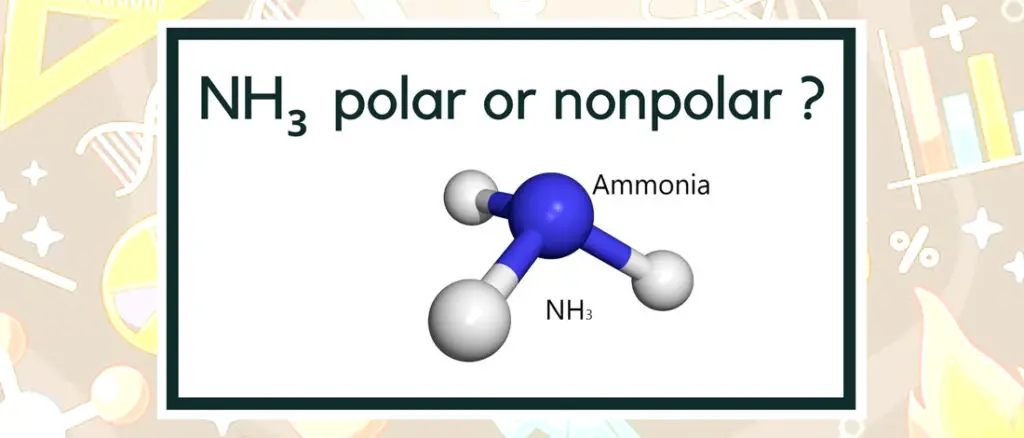Ammonia, or NH3, is a colorless gas that occurs in a gaseous state at room temperature and is composed of polar molecules such as one atom of Nitrogen and three atoms of Hydrogen. Ammonia has a pungent smell and fertilizer content As a cleaning chemical and nitrogenous compounds. Vegetable matter and nitrogenous animal waste products are both sources of this polar molecule. During rain, however, small quantities of ammonia and ammonium salts are detected.
Here are some of the other properties of NH3, and for better understanding, we will answer the question, Is NH3 polar or nonpolar?
Contents
NH3 (Ammonia) : Polar or Nonpolar?
Ammonia with a chemical formula of NH3 is a polar molecule because the NH3 molecule possesses three dipoles that do not cancel each other. [1] Three H atoms form a covalent bond in ammonia molecules by sharing three electrons between the nitrogen and hydrogen atoms, leaving a lone pair on the nitrogen atom.
Due to the repulsive forces of the bonding pair of electrons, the bond angle reduces from 109.5 to 107° and forms a tetrahedral shape. If you now closely look at the molecule, it has an asymmetrical shape which means it is not polar. As the electrons are arranged asymmetrically, there is a net dipole moment in this molecule.

Name of Molecule | Ammonia or Nitrogen Trihydride |
Molecular Mass | 17.03052 g/mol |
Dipole Moment | 1.46 D |
Bond Angle | 107° |
Hybridization | sp3 |
Molecular Geometry/Shape | Trigonal Pyramidal |
Molecular Structure
Covalent chemical bonding is found in NH3. Nitrogen forms a covalent bond along with the three atoms of Hydrogen. The lone pair deploys a repulsive force on the three bond pairs N-H. Look at the lewis structure to better understand electron geometry, polarity, and other features of polar molecules and nonpolar molecules.
The overall shape of the NH3 molecule is a trigonal pyramidal structure. If we explain the atom positions, Nitrogen is a central atom with an asymmetric charge distribution, three bonds, and one lone pair.

What Determines The of Polarity NH3

NH3 Dipole Moment
If two atoms forming a link in a covalent molecule have differing electronegativities, they spread uneven charges, resulting in the bond’s polarity. It’s also worth noting that the bond’s polarity is proportional to the difference in the electronegativities of both atoms.
The three bonds in the NH3 molecule contain three dipoles that do not cancel each other out. They combine to provide a net dipole moment. With the asymmetrical shape of the polar molecule, dipole moments in NH3 are predicted to be approximately 1.46D. These chemical compounds produce asymmetrical molecules by forming polar bonds between their atoms.
NH3 Electronegativity
Once uneven charges are distributed, the electronegativity difference is the initial defining characteristic of a covalent compound. The stronger the polarity, the more electronegative the atoms on a covalent bond are, similar to what we see with nitrogen atoms.
Nitrogen has a computed electronegativity of 3.04, whereas Hydrogen has a calculated electronegativity of 2.2. As a result of the variations in electronegativities, the three N-H bonds produce three dipole moments in one direction.
Related Posts:
- Is PF3 Polar or Nonpolar?
- Is PH3 Polar or Nonpolar?
- Is XeF4 Polar or Nonpolar?
- Is CH2Cl Polar or Nonpolar?
NH3 Geometric Shape
Ammonia’s molecular geometry is tetrahedral, as previously stated. The nonpolar molecule is symmetrically distributed throughout the Nitrogen base. The valence electrons in N’s outer shell are five, whereas the valence electrons in the outer shell of H atoms are only one. However, we have three with a central atom in this group.
Two nonpolar molecules produced the NH3 trigonal pyramidal shape. The bent structure of the polar molecule generated by electron-electron repulsion resulted in a strong partial charge. [2] In fact, this is an even more powerful polar net dipole moment.
FAQs
Polarity is an Ammonia molecule that is influenced by its asymmetrical geometry and nitrogen and hydrogen atoms inside it. A molecule of Ammonia is polar because the N atoms have a higher electronegativity than the hydrogen atoms.
No, Ammonia doesn’t have a positive charge. When the component atoms at one end of the molecule have a net positive charge, it is polar. In contrast, Ammonia has a net negative charge on the other end of its molecule
Yes. Although NH3 has dipole-dipole intermolecular interactions, the polarity is due to the strongly electronegative atoms. Because of this, NH3 remains a hydrogen bond.
One reminder to keep in mind is that because the nitrogen atom only has one lone pair, the quantity of hydrogen bonding is limited.
In Summary
The geometrical structure of Ammonia is tetrahedral because it is an asymmetrical molecule with three Hydrogen atoms and one nitrogen atom. When two atoms form chemical bonds, they become asymmetrical molecules with polar bonds. So, is NH3 polar?
The answer is yes. The large difference in the electronegativity between Nitrogen and Hydrogen makes the N-H bond polar. The N-H bond’s dipole moments add to a net dipole moment for the Ammonia molecule, making it a polar molecule. Also, the partial charges are not evenly distributed across the molecule, with a negative charge at the top.
Thank you for reading this far! I hope that the information provided in this article will be helpful to you.
References:
- https://pubchem.ncbi.nlm.nih.gov/compound/Ammonia
- https://courses.lumenlearning.com
- 8 Best Books On Evolution (2023 Updated) - May 16, 2022
- How Could Natural Selection Lead To Evolution? (2023) - May 16, 2022
- How Do Fossils Provide Evidence For Evolution? (2023) - May 16, 2022

